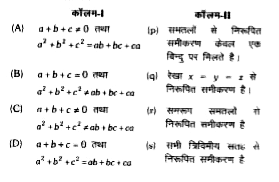रेखाएँ a1x+b1y+c1z+d1=0 तथा a2x+b2y+c2z+d2=0 के दिक अनुपात हैं
a1b2a2,b1c2−c1b2,c1d2−d1c2
b1b2−c1c2,c1c2−a1a2,a1a2−b1b2
b1c2−c1b2,c1a2−c2a1,a1b2−baa2
a1a2+b1b2+c1c2+c1c2+d1d2,c1c2+d1d2+a1a2
The correct Answer is:C
Step by step video, text & image solution for रेखाएँ a_(1)x+b_(1)y+c_(1)z+d_(1)=0 तथा a_(2)x+b_(2)y+c_(2)z+d_(2)=0 के दिक अनुपात हैं by Maths experts to help you in doubts & scoring excellent marks in Class 12 exams.
Updated on:21/07/2023Topper's Solved these Questions
- त्रिविमीय निर्देशांक ज्यामिति BOOK - ERRORLESS HINDICHAPTER - त्रिविमीय निर्देशांक ज्यामिति EXERCISE - MULTIPLE CHOICE QUESTIONS (रेखा)
22 Videos
- त्रिविमीय निर्देशांक ज्यामिति BOOK - ERRORLESS HINDICHAPTER - त्रिविमीय निर्देशांक ज्यामिति EXERCISE - MULTIPLE CHOICE QUESTIONS (समतल)
46 Videos
- त्रिविमीय निर्देशांक ज्यामिति BOOK - ERRORLESS HINDICHAPTER - त्रिविमीय निर्देशांक ज्यामिति EXERCISE - JEE ADVANCED (Matrix Match type questions)
4 Videos
- त्रिकोणमितीय अनुपात, फलन एवं सर्वसमिकायेBOOK - ERRORLESS HINDICHAPTER - त्रिकोणमितीय अनुपात, फलन एवं सर्वसमिकायेEXERCISE - JEE Advanced (Matrix Match type questions)
5 Videos
- द्विपद प्रमेय तथा गणितीय आगमन BOOK - ERRORLESS HINDICHAPTER - द्विपद प्रमेय तथा गणितीय आगमन EXERCISE - JEE Advanced (Matrix Math type questions)
5 Videos
Similar Questions
बिन्दु (x1,y1,z1) की रेखा x−x2l=y−y2m=z−z2n से दुरी, जहाँ l,m,n रेखा की दिक् कोज्यायें हैं, है
View Solutionयदि बिन्दु P(1,-2,1) से समतल x+2y−2z=α , जहाँ a>0 की दूरी 5 है तो बिन्दु P से समतल पर डाले गए अभिलम्ब का पाद (foot) निम्न है:
View Solutionमाना निम्न रैखिक समीकरण है ax+by+cz=0,bx+cy+oz=0,cx+ay+bz=0 कॉलम । में दी गयी स्थितियों/व्यंजकों का कॉलम ॥ में दिए गए वक्तव्यों से सुमेल करें

View Solutionनिम्नलिखित कॉलम I को कॉलम II से मिलाये

View Solutionनिम्नलिखित कॉलम I को कॉलम II से मिलाये

View SolutionCosnsider the system of equation
a1x+b1y+c1z=0,a2x+b2y+c2z=0,
a3x+b3y+c3z=0 if ∣∣ ∣∣a1b1c1a2b2c2a3b3c3∣∣ ∣∣=0, then the
system has
View SolutionConsider the system of equations
a1x+b1y+c1z=0
a2x+b2y+c2z=0
a3x+b3y+c3z=0
If ∣∣ ∣∣a1b1c1a2b2c2a3b3c3∣∣ ∣∣=0, then the system has
View SolutionSuppose the system of equations
a1x+b1y+c1z=d1
a2x+b2y+c2z=d2
a3x+b3y+c3z=d3
has a unique solution (x0,y0,z0). If x0=0, then which one of the following is correct ?
View Solutionयदि a1x+b1y+c1z+d1=0 तल और a2x+b2y+c2z+d2=0तल परस्पर लंब हैं, तो
View SolutionFor the system of equations :
a1x+b1y+c1z=0,a2x+b2y+c2z=0,a3x+b3y+c3z=0
if ∣∣ ∣∣a1b1c1a2b2c2a3b3c3∣∣ ∣∣=0, then this system has:
View SolutionIf the lines x=a1y+b1,z=c1y+d1 and x=a2y+b2,z=c2y+d2 are perpendicular, then
View Solutionप्रदत्त बिंदु (α,β,γ) से गुजरनेवाली और तलों a1x+b1y+c1z+d1=0,a2x+b2y+c2z+d20 के समांतर रेखा के समीकरणों को प्राप्त कीजिए ।
View SolutionIf the lines x=a1y+b1,z=c1y+d1 and x=a2y+b2,z=c2y+d2 are perpendicular, prove that, 1+a1a2+c1c2=0.
View SolutionA : The area of the parallelogram formed by 4x−7y−13=0,8x−y−39=0,4x−7y+39=0,8x−y+13=0 is 52.
R : The area of the parallelogram formed by a1x+b1y+c1=0,a1x+b1y+d1=0,a2x+b2y+c2=0,a2x+b2y+d2=0 is ∣∣∣(c1−d1)(c2−d2)a1b2−a2b1∣∣∣
View SolutionConsider the system of linear equations
a1x+b1y+c1z+d1=0,
a2x+b2y+c2z+d2=0,
a3x+b3y+c3z+d3=0, Let us denote by Δ (a,b,c) the determinant ∣∣ ∣∣a1b1c1a2b2c2a3b3c3∣∣ ∣∣ , if Δ(a,b,c)# 0, then the value of x in the unique solution of the above equations is
View Solution
